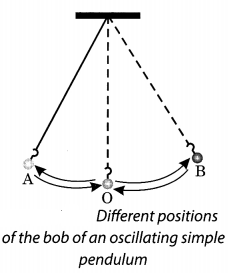Ncert solutions for class 7 science Motion and Time – notes of class 7 science motion and time with questions and answers and explanations.
Table of Contents
Summary – Ncert solutions for class 7 science Motion and Time

Distance
- Distance – total path covered by the object in the given interval of time.
- Displacement – shortest path covered by the moving object in the given interval of time.
- Distance= Speed×Time.
- Unit of distance – measured in units of length like metres, kilometres etc.
Motion
- An object is said to be in motion if it changes its position with respect to time and it is at rest if the object does not change its position with time.
- Read more: NCERT Solutions For Class 7 Science Chapter 9 Soil
Types of motion
1. Rectilinear / translatory motion: When a body is moving in a straight line, without changing its direction, then the body is said to possess translatory/rectilinear motion.
Eg: A car moving on a straight road.
2. Circular motion: When a body moves in the shape of a circle about a fixed point and a fixed radius, then the body is said to be in circular motion.
Eg: Motion of planets around the sun.
3. Period / Oscillatory motion: When the motion of a body repeats after fixed intervals of time, then the body is said to in the periodic/oscillatory motion.
Eg: To and fro motion of a simple pendulum.
Periodic or oscillatory motion
- Periodic or oscillatory motion is the motion in which a body repeats its motion after fixed intervals of time.
- Eg: To and fro motion of a simple pendulum, Motion of a car in a circular path, Motion of planets around the sun.
Speed
- It is the total distance travelled by the object in a given interval of time.
- Speed = Distance travelled/time taken
- Unit of speed is generally measured in metre per second(m/s), kilometre per hour(km/h).
Uniform and Non-Uniform Motion
1. Uniform motion: When an object moving along a straight line moves with a constant speed, then the object is said to be in uniform motion.
Eg: A car moving in a straight line with a constant speed.
2. Non-uniform motion: When an object moving along a straight line changes its speed with respect to time, then the object is said to be in uniform motion.
Eg: The motion of a train.
Conclusion Ncert solutions for class 7 science Motion and Time
Ncert solutions for class 7 science Motion and Time – notes of class 7 science motion and time with questions and answers and explanations have been provided above for science chapter 13.
Questions and Answers – Ncert solutions for class 7 science Motion and Time
1. Classify the following as motion along a straight line, circular or oscillatory motion:
(i) Motion of your hands while running.
(ii) Motion of a horse pulling a cart on a straight road.
(iii) Motion of a child in a merry-go-round.
(iv) Motion of a child on a see-saw.
(v) Motion of the hammer of an electric bell.
(vi) Motion of a train on a straight bridge.
Solution:
i) oscillatory
ii) Motion along a straight line
iii) Circular motion
iv) Oscillatory motion
v) Oscillatory motion
vi) Motion along a straight line.
2. Which of the following are not correct?
(i) The basic unit of time is second.
(ii) Every object moves with a constant speed.
(iii) The Distance between two cities are measured in kilometres.
(iv) The time period of a given pendulum is constant.
(v) The speed of a train is expressed in m/h.
Solution:
Incorrect statements are:
(ii) Every object moves with a constant speed.
(iv) The time period of a given pendulum is constant.
(v) The speed of a train is expressed in m/h.
Sums – Ncert solutions for class 7 science Motion and Time
3. A simple pendulum takes 32 s to complete 20 oscillations. What is the time period of the pendulum?
Solution:
Number of oscillations = 20
Total time taken to complete 20 oscillations = 32 s

4. The distance between two stations is 240 km. A train takes 4 hours to cover this distance. Calculate the speed of the train.
Solution:
Distance between two stations = 240 kms
Total time take = 4 hrs/240 minutes

= 60 km/h
5. The odometer of a car reads 57321.0 km when the clock shows the time 08:30 AM. What is the distance moved by the car, if at 08:50 AM, the odometer reading has changed to 57336.0 km? Calculate the speed of the car in km/min during this time. Express the speed in km/h also.
Solution:
Initial reading of the odometer = 57321.0
Final reading of the odometer = 57336.0
Distance covered by the car = Final reading of the odometer – Initial reading of the odometer
= 57336.0 – 57321.0 = 15 kms
Starting time of car is 8:30 and it stops at 8: 50
Hence, time taken by car = 20 mins

= 45 km/h
6. Salma takes 15 minutes from her house to reach her school on a bicycle. If the bicycle has a speed of 2 m/s, calculate the distance between her house and the school.
Solution:
Time taken by Salma to reach her school by bicycle = 15 mins= 15 x 60 = 90 s
Speed of Salma’s bicycle= 2m/s

Distance covered = speed x time taken
= 2 x 900 = 1800 m
1000m = 1 km

= 1.8 kms
Sums
7. Show the shape of the distance-time graph for the motion in the following cases:
(i) A car moving with a constant speed.
(ii) A car parked on a side road.
Solution:


8. Which of the following relations is correct?
(i) Speed = Distance × Time
(ii) Speed = Distance/Time
(iii) Speed = Time/Distance
(iv) Speed = 1/Distance x Time
Solution:
Answer is (ii) Speed = Distance/Time
9. The basic unit of speed is:
(i) km/min
(ii) m/min
(iii) km/h
(iv) m/s
Solution:
Answer is (iv) m/s
10. A car moves with a speed of 40 km/h for 15 minutes and then with a speed of 60 km/h for the next 15 minutes. The total distance covered by the car is:
(i) 100 km (ii) 25 km (iii) 15 km (iv) 10 km
Solution:
The answer is (ii) 25 km
Calculation:
When the speed of the car is 40 km/h
Time taken = 15 min = 15/60 = 0.25 h

Distance covered d1 = speed x time taken
= 40 x 0.25 = 10 kms
When the speed of the Car is 60 km/ h

Distance covered d2 = speed x time taken
= 60 x 0.25= 15 kms
Total distance covered by the car = d1 + d2
= 10 + 15
= 25 kms
Figures
11. Suppose the two photographs, shown in Fig. 13.1 and Fig. 13.2, had been taken at an interval of 10 seconds. If a distance of 100 metres is shown by 1 cm in these photographs, calculate the speed of the fastest car.

Solution:
The distance covered by the blue car (as evident from the photograph) from one horizontal white strip to another, which is measured by scale is 1.2 cm.
It is given that 1 cm is equivalent to 100 m.
Therefore, 1.2 cm is equivalent to 120 m.
Distance travelled by the car = 120 m
Time taken to cover this distance = Time interval between the two photographs = 10 s

= 120/10
= 12 m/s
12. Fig. 13.15 shows the distance-time graph for the motion of two vehicles A and B. Which one of them is moving faster?

Solution:
Vehicle A is moving faster than vehicle B.
13. Which of the following distance-time graphs shows a truck moving with speed which is not constant?


Solution:
Answer is iii)





